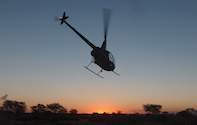
Culling Elephants
In the mid 70s to lighten the additional workload caused by the construction of the fence on the border of Mozambique. He was based in Skukuza and as one of the three pilots alternated between the three major workloads of fence construction, nature conservation and tourism and technical services.
He says that this meant he mostly worked in three-week cycles that provided quite a bit of variety. One week he was hauling cement and other material to fencing crews; the next week taking rangers or biologists out to work sites, or doing a game census, or (most usually) culling elephant or buffalo; and the third week taking technicians out to fix water pumps or flying VIPs around the Park.
'What I enjoyed most were the culling camps - the opportunity to spend a week in some remote part of the park, camping in caravans and cooking over open fires, and listening to the yarns of the district ranger. The flying was more interesting too, though the culling itself was unpleasant and (in the case of the elephants) became increasingly distasteful to me, though I believed in the culling policy, which seemed to me necessary to prevent habitat destruction and other adverse impacts from unbalanced populations.'
Roy was born and grew up in the United States of America. His wife Pat and step children Duane and Tersia, nine and seven at the time, had never lived outside a city before their stay at Skukuza.
'The kids were young and they loved the bush and life in Skukuza - they will still tell you today that this was the best year of their lives.' He says the staff and park were exceptionally kind and accommodating to him and his family and he remembers being very impressed with their professionalism and dedication to conservation. It was a small community and he found the people extraordinarily kind and considerate, welcoming them without reservation.
Roy recalls that life was very pleasant in Skukuza and he felt part of a special family that 'every day played host to visitors (tourists).' He said: 'Conservation was the pre-eminent concern of the staff, but tourism was not neglected. In fact I remember thinking of tourists as extended family who were visiting us and keen to learn something about what we are doing and why. This was a good and warm feeling.'
The Elephant That Wouldn't Budge
One day we had a call from a ranger in the southern district that sugar cane farmers just outside the Park were complaining that elephants were in their sugar cane. (The southern boundary of the Park was not fenced at that time since the Crocodile River served as a reasonably effective barrier to keep game animals inside the Park. An elephant can do a lot of agricultural damage in a short time, so I got in the helicopter and flew right down.
After picking up the ranger we headed out to the farms and soon found the elephants indulging their sweet tooth. We herded them back toward the Park, and everything went well until we got to the Crocodile River. All the elephants finally entered the river except one big bull, who just didn't want to go in. I got down close to him and eventually got him into the river, but then he stopped on a sand bar in the middle and refused to budge another inch.
We drove the rest of the elephants across the river and into the Park, and then went back for the stubborn one on the sandbank. I flew up close to him again, and hovered over him for a while throwing downwash on him, but this time he stood his ground. In fact, he kept turning to face me, with his ears back and his trunk down, ready for a fight. Then I decided to climb up and make a high-speed dive down on him.
He was watching me all the time as I got into position to make a diving run, and facing me as I came down. I made a quick stop just a few feet away, thinking the noise and the downwash and the sudden rush out of the sky would frighten him into turning and running. But instead, he suddenly reared up on his hind feet to confront me, and his trunk very nearly got hold of my right skid.
This was quite a frightening sight to view through the plexiglass below my rudder pedals; an enraged elephant looming just inches away with his trunk reaching out for me. I shudder to think what would have happened if he had gotten a hold of the skid; I'm sure he could have easily turned me over to one side and we probably would have crashed. Fortunately he didn't quite grab the skid, and we got away.
The ranger asked me not to do that again; it made him nervous. The ranger then had another idea, and he asked me to go to a gravel bar a short distance away and land, which I did. He got out and picked up some big rocks, which he heaved aboard, and then he asked me to go back and hover over the elephant. The defiant animal was still wanting a fight, but after the ranger threw some big rocks down on him, it finally decided to cooperate and crossed the river. This was an interesting case of adding a low-tech method to a high-tech method to solve a problem with a very stubborn elephant.

